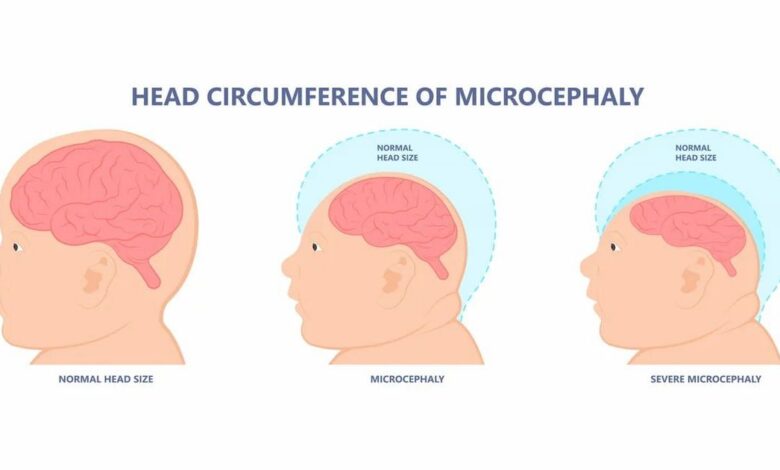Microcephaly: What's it, causes, symptoms, diagnostics, treatment, prevention

Microcephaly
Microcephaly: What's it?
Microcephaly – it is a rare congenital condition, in which the head size and brain volume are smaller, than usual. It can be caused by improper brain development in the womb or as a result of genetic mutations..
Causes of microcephaly
Microcephaly is most often caused by, that the brain does not grow at a normal rate. The growth of the skull is determined by the growth of the brain. Brain growth happens, while the baby is in the womb and in infancy.
Conditions, affecting brain growth, can lead to a reduction in head size compared to normal. These include infections, genetic disorders and severe malnutrition.
Genetic disorders, causing microcephaly, include:
- Cornelius de Lange syndrome
- crying cat syndrome
- Down's syndrome
- Rubinstein-Taibi Syndrome
- Seckel syndrome
- Smith-Lemli-Opitz syndrome
- Trysomyya 18
- Trysomyya 21
Other problems, which can lead to microcephaly, include:
- Uncontrolled phenylketonuria (PKU) mother
- Methylmercury poisoning
- congenital rubella
- Congenital toxoplasmosis
- Congenital cytomegalovirus (CMV)
- Use of certain medications during pregnancy, especially alcohol and phenytoin
Zika virus infection during pregnancy can also cause microcephaly. The Zika virus was discovered in Africa, South Pacific, tropical regions of Asia, as well as in Brazil and other parts of South America, and also in Mexico, Central America and the Caribbean.
Symptoms of microcephaly
The main symptom of microcephaly is a significantly smaller head size in a child compared to age norms.. Other possible symptoms may include:
- Smaller head size, measured by head circumference;
- Developmental delay and speech delay;
- Problems with hearing and vision;
- Difficulties with learning and intelligence;
- Epileptic seizures and other neurological problems.
When to see a doctor
If your child has signs of microcephaly, it is important to see a doctor for evaluation and advice. The following cases may require immediate medical attention:
- Lack of head growth or head growth below the age standard;
- Significant developmental delay and developmental delay;
- The appearance of other symptoms, such as eating problems, movement or breath.
Questions, which the doctor may ask
When contacting a doctor with microcephaly, the doctor may ask you some questions, to better understand your child's situation and medical history. Some of the possible questions might include:
- When did you notice, that the baby's head is smaller?
- Have you had a family history of microcephaly??
- Have you had problems with pregnancy or childbirth?
- What other symptoms is your child experiencing??
Diagnosis of microcephaly
Diagnosis of microcephaly begins with an examination of the child and the collection of a medical history. The doctor may take into account the size of the child's head, ultrasound results (US) heads, as well as other medical information. In addition, the following diagnostic procedures may be recommended:
- Genetic tests: In some cases, genetic testing may be required to identify possible genetic abnormalities.
- head ultrasound: An ultrasound of the head can be used to confirm the diagnosis and evaluate the size of the brain and skull..
Treatment of microcephaly
Treatment of microcephaly depends on the specific situation and the development of the child.. Approaches may include the following:
- Symptom management and support: The doctor may recommend specific programs or therapies to help the child develop and reach their potential..
- Rehabilitation services: The child can receive support and assistance from development and rehabilitation specialists, such as physical therapists, speech or visual therapy.
- Complication management: A child with microcephaly may be prone to various complications., such as epileptic seizures or mental retardation. Your doctor may recommend treatments or programs to manage these complications..
Treatment of microcephaly at home
Treatment of microcephaly usually requires medical intervention and specialized programs.. Home treatment may include the following:
Treatment for microcephaly often includes long-term involvement and support from parents and caregivers.. Home care may include:
- Stimulation of development: Parents can do exercises and games, which contribute to the development of motor and cognitive skills.
- Learning support: Parents can collaborate with education specialists, to provide the best learning experience for the child.
- Regular observation: Regular visits to the doctor and other specialists will help track progress and take the necessary measures..
Prevention of microcephaly
The following steps may help reduce the risk of developing microcephaly:
- Health care during pregnancy: Proper nutrition, vitamin intake, moderate physical activity and the absence of alcohol and drugs can keep the fetus healthy.
- Infection prevention: Avoid contact with contagious diseases, such as the Zika virus, especially during pregnancy.
- genetic counseling: If you have a history of genetic diseases in the family, genetic counseling before pregnancy can help determine risks.
In conclusion, microcephaly – this is a serious condition, requiring the attention of specialists and an individual approach to treatment. If you find your child has signs of microcephaly or are concerned about its development, be sure to consult your doctor for a professional assessment and recommendations. The best result can be achieved with timely diagnosis and support from medical experts.
Used sources and literature
Antoniou E, Orova E, Sarella A, et al. Zika virus and the risk of developing microcephaly in infants: a systematic review. Int J Environ Res Public Health. 2020;17(11):3806. PMID: 32471131 pubmed.ncbi.nlm.nih.gov/32471131/.
Centers for Disease Control and Prevention website. Zika virus. www.cdc.gov/zika/index.html. Updated September 20, 2021. Accessed January 19, 2022.
Kinsman SL, Johnston MV. Congenital anomalies of the central nervous system. In: Kliegman RM, St. Geme JW, Bloom NJ, Shah SS, Tasker RC, Wilson KM, eds. Nelson Textbook of Pediatrics. 21st ed. Philadelphia, PA: Elsevier; 2020:chap 609.
Scale GM, Dobyns WB. Disorders of brain size. In: Swaiman KF, Ashwal S, Ferriero DM, et al, eds. Swaiman’s Pediatric Neurology: Principles and Practice. 6th ed. Philadelphia, PA: Elsevier; 2017:chap 28.
